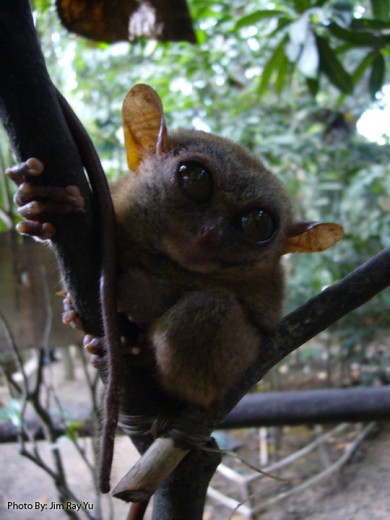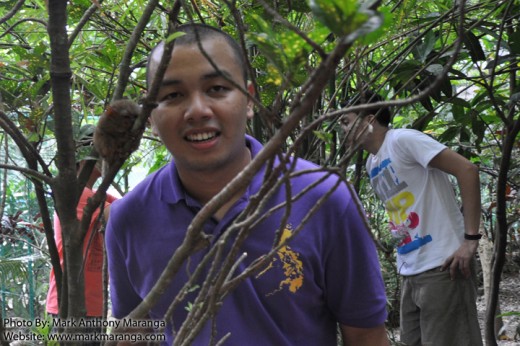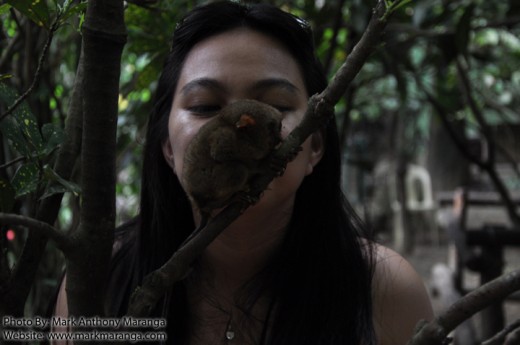The Philippine Tarsier is found in the islands of Samar, Leyte, Cebu (Crocolandia), Bohol and a lot of places in Mindanao. It has always been associated to Bohol because of its (used to be) numerous & well-preserved species found in the land.
The Philippine Tarsier is already an endangered species found in the Philippines. It’s scientifically known as Tarsius syrichta and also called Maumag in Cebuano/Visayan. It derived its name from its elongated “tarsus” bone or ankle bone.
The Philippine Tarsier is considered to be the world’s smallest primate, measures about 12 centimeters in length. Mostly active at night, their two big eyes are fixed in its skull and don’t have the upper protective tissue. That’s why the Philippine Tarsier learned to turn their heads 180 degrees. Their huge eyes provide this nocturnal animal with night vision. It has a thin rough fur which is usually colored gray to dark brown and weighs 113-142 grams. Male tarsiers are larger than females.
The Philippine Tarsiers can jump at least three meters from tree to tree without touching the ground with the help of its elongated tarsus bone. It mainly lives on insects and clings on small shafts of trees. Their ears are mobile appearing to be constantly moving allowing them to hear any movements.
Before, the Philippine Tarsiers freely roamed in dense patches of tall grasses, bamboos and small trees in tropical forest. They used to be a common sight in the highways of Corella town in Bohol. But as years go by, hunters caught thousands of tarsier and sell them as pets or sold for trade.
The Philippine Tarsiers rarely live long in captivity because of their need for live insects upon which to feed. Aside from the hunters, dwindling down the forests has placed significant threat to the survival of the Philippine Tarsier because this results in the destruction of its natural forest habitat. Continuous illegal logging, slash and burn method of agriculture and urbanization caused tarsiers to be threatened and become endangered.
Today, there are about 1,000 Philippine Tarsiers left in the wild of Corella town in Bohol. The Local Government of Bohol along with Department of Environment and Natural Resources (DENR) has been very active in preserving the Philippine Tarsiers. They launched the reforestation program which attempts to restore deforested areas by plating indigenous tree species.
Later on, they launched the Philippine Tarsier Foundation Incorporated which is based in Tagbilaran City, Bohol, Philippines. This will spearhead the campaign in preserving the Philippine Tarsiers. To date, the foundation has acquired 7.4 hectares of land in Corella, Bohol for the sanctuary. This has been possible with the help of DENR and the Local Government of Bohol.
Since the tarsier sanctuary in Corella is off to tourist, private individual in Loboc, Bohol where the Loboc River’s Floating Restaurant is found, have provided an alternative way for tourist to see the famous Philippine Tarsiers. This captive tarsier display is conveniently found on the way to other tourist spot like Bohol Man-Made Forest (where a lot of them inhabited) and the Chocolate Hills in Bohol. This has been made possible because DENR has granted special permits for this display of Philippine Tarsier in Loboc. This way, tourists can see the primate up close and personal but touching them are not allowed.
You can try and visit the Philippine Tarsier Foundation for more information:
The Philippine Tarsier Foundation,
Km. 14 Canapnapan Corella, Bohol 6300 Philippines
Tel: (0912) 5163375
Mobile: (0918) 6021326
Email: tarsier@mozcom.com
Website: http://www.philippinetarsier.org/
This page is last updated on



 Mark Anthony Maranga is an Educator-Parent to his 3 Homeschooling Kids. He sells
Mark Anthony Maranga is an Educator-Parent to his 3 Homeschooling Kids. He sells 










Went to see many places in one day with Mr. Dodong, our guide/driver/company who is awesome!
The Tarsier sanctuary was an awesome experience. Gave me and my family a different level of appreciation for these beautiful and endangered animals.